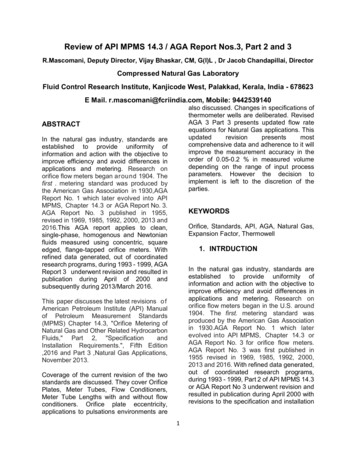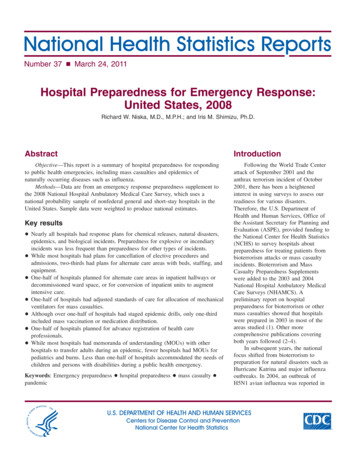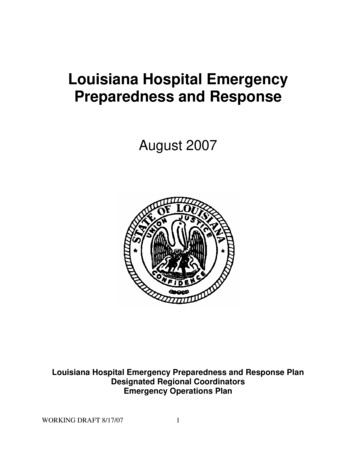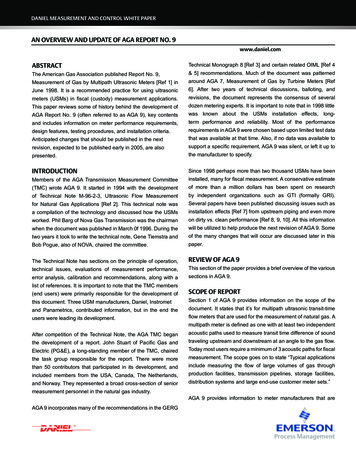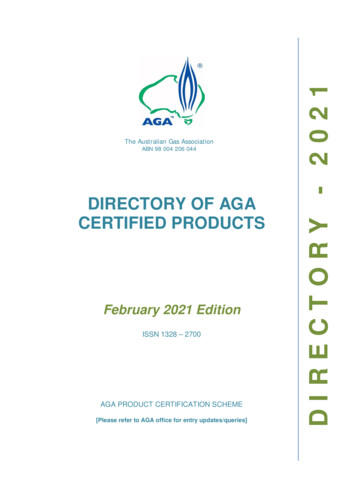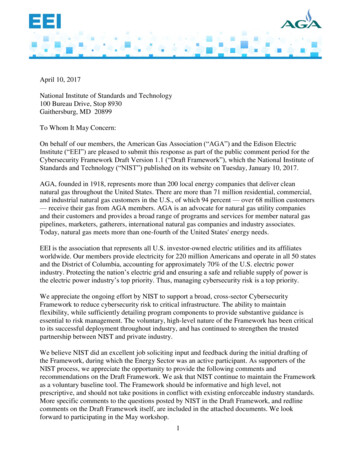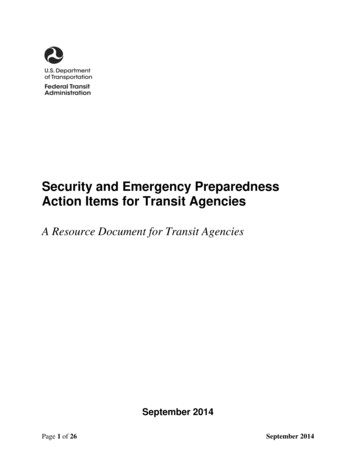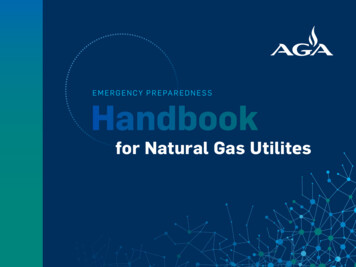
Transcription
E M E R G E N C Y P R E PA R E D N E S SHandbookfor Natural Gas Utilites
AGA EmergencyPreparedness HandbookThe American Gas Association (AGA), foundedin 1918, represents more than 200 local energycompanies that deliver clean natural gas throughoutthe United States. There are more than 73 millionresidential, commercial and industrial natural gascustomers in the U.S., of which 95 percent — morethan 69 million customers — receive their gas fromAGA members. Today, natural gas meets more thanone-fourth of the US' energy needs.1FIND MOREON LI N Ewww.AGA.org
PurposeThis handbook provides a framework forcollaboration in addressing potential crisisactivities impacting member natural gasutilities of AGA, MEA Energy Association,Northeast Gas Association (NGA), SouthernGas Association (SGA), and the Western EnergyCONTACTSKimberly Denbow, 202-824-7334;kdenbow@aga.orgJackie Malatesta, 202-824-7204;jmalatesta@aga.orgInstitute (WEI) by outlining mutual assistanceopportunities. This includes delineating rolesof the lead gas association, which may be aregional gas association or AGA dependingupon the extent of the impacted utilities’needs. This handbook ensures governmentand industry are communicating and availableto support response and recovery efforts ifnecessary – leveraging and coordinating theunique roles, responsibilities, capabilities,and assets of both.A G A E M E R G E N C Y P R E PA R E D N E S S H A N D B O O K2
N AT U R A L G A SValue ChainNatural gas is an odorless, colorless, naturallyoccurring hydrocarbon consisting mostly of methane(70-90 percent) and other gases. The naturalgas value chain is extensive and spans from theproduction well-head to the consumer burner-tip.The natural gas industry and associated response,recovery, and emergency preparedness activitiesare best distinguished by three distinct segments.3
Production & ProcessingFound in reservoirs deep within the earth andbrought to surface through production wells.Gathering lines transport natural gas fromwellhead to transmission.Transmission & StorageTransmission lines transport natural gas fromprocessing to storage facility and/or large-volumecustomer (e.g., local distribution system, naturalgas-fired power generation, etc.).DistributionSee AppendixA for furtherdescription ofeach segmentand associatedfunction.Distribution lines receive natural gas from thetransmission line and transport the gas to theconsumer (residential/commercial/industrial).A G A E M E R G E N C Y P R E PA R E D N E S S H A N D B O O K4
Each segment approaches emergency preparednessand response/recovery differently. For example, naturalgas distribution companies generally participate inmutual assistance programs with other gas utilities andcontractors, while upstream natural gas productioncompanies have assistance programs which are morecontractor-based, taking into consideration differentbusiness models and antitrust laws. Depending upon thesegment of the value chain, the policies and practicesmay differ to best match the needs of and regulatoryrestrictions on the segment of interest.This handbook focuses on natural gasdistribution emergency preparednessprograms and practices.5
StakeholdersAGA works closely with federal government partners and other organizations at the requestof AGA members or regional natural gas associations to facilitate efficient information sharing,build situational awareness and enable effective risk-informed decision-making.AGAGovernmentMEMBERSFEDERALGas UtilitiesTransmissionVendorsA G A S TA F FDNG ISACSector Specific Agency'sDepartment of Homeland SecurityTransportation Security AdministrationDepartment of EnergyU.S. Coast GuardFederal Energy Regulator CommissionNon-AGAOther TradeAssociationsOil & Natural GasSector CoordinatingCouncilCross-sectorEnergy industryEnergy Information AgencyEnvironmental Protection AgencyS TAT ELocal Utilities CommissionGovernorLOCALMunicipal or County Leadership andIncident CommandersSee AppendixB for furtherdescription ofeach segmentand associatedfunction.Working with state andlocal governments as wellas local media is generallyhandled by the impactedutilities and/or regionalgas associations asappropriate.A G A E M E R G E N C Y P R E PA R E D N E S S H A N D B O O K6
StructureNatural gas distribution mutual assistance depends upon the extent ofdamage to the distribution system. If response/recovery can be managedusing regional resources, then the natural gas association, in the regionin which the crisis is occurring, takes the lead in helping coordinateactivities of neighboring utilities.* AGA monitors response/recoveryefforts and offers a channel of communication to the Federal government,e.g., requesting waivers for Operator Qualification requirements to beinstituted, as appropriate. If needs exceed the capacity of regionalresources, the AGA mutual assistance program is initiated at the requestof the regional association.*This is generally the case unless AGA is requested to by the impacted AGAmember company to take the lead in helping coordinate efforts.7
AGA MutualAssistance ProgramAGA offers its members (utilities, transmission, and manufacturers/suppliers/service providers) a voluntary, no-fee mutual assistanceprogram designed to suit the wide variation of needs of its membercompanies across the United States and Canada.The purpose of the AGA program is to supplement local, stateand regional mutual assistance programs and is intended forunprecedented man-made or natural disasters requiring thededication of response/recovery/restoration resources outsidethe limits of existing mutual aid programs.A G A E M E R G E N C Y P R E PA R E D N E S S H A N D B O O K8
AGA MutualAssistance ProgramThe AGA program is based on a coalition of AGA membercompanies, which agree to a set of baseline provisions thatgovern mutual assistance and agree to populate and maintainthe AGA Mutual Assistance Database with company-specificemergency contact information, field capabilities and other keyresources available for mutual assistance. The incorporation ofthe AGA Mutual Assistance Program into a company's emergencyplanning portfolio enhances advanced planning and effectuatesresponse efforts in time of extenuating circumstances.9
Natural gas utilities operate differently across the U.S. Mutual assistance isadministered, communicated, and managed non-linearly among natural gas utilitiesto afford flexibility.The chart below delineates the process for gas.OPERATIONSEMERGENCYRESPONDERS(external)9-1-1 DispatchFireLaw EnforcementEmergency MedicalServicesPublic SafetyEnvironmentManagementPipeline SupervisorsPipeline OperatorsSCADA OperatorsField TeamsCompany RespondersOTHER COMPANIESUtilitiesConstruction FirmsSuppliersPUBLICNearby ResidentsCommunity LeadersEmployeesServicesMediaOtherUtilities across our nation are increasingly integrating NationalIncident Management System (NIMS) into their planningand incident management structure. AGA's role in this is tosupport the regional association's and/or impacted utilities'communications and resource management, as appropriate,and serve as the conduit for information flow and situationalawareness to and from the federal government.Source: Guide for Communicating Emergency Response Information for Natural Gas & Hazardous Liquids Pipelines.A G A E M E R G E N C Y P R E PA R E D N E S S H A N D B O O K10
Information FlowWithin Regional Capacity*NOTE: The operators may alsobe communicating directly withtheir state and local EmergencyOperations Centers and Mediaas well as with the RegionalAssociation.*T his model is bypassedwhen an operatordirectly requests AGAcoordination iationsAGADNG-ISACStateGovernmentMedia
Information FlowBeyond Regional CapacityAGANOTE: The operators may alsobe communicating directly withtheir state and local EmergencyOperations Centers and Media aswell as with ralGovernmentMediaNon-AGAA G A E M E R G E N C Y P R E PA R E D N E S S H A N D B O O K12
Unity of MessageDOEStatesLocal Emergency Operation CentersDHSTSAAGAAGA Gas UtilitiesAGA Transmission PipelinesAGA Associates (Vendors)Non-AGARegional Natural Gas AssociationsDNG ISAC13GovtUnity of MessageUnity of Effort
Preparedness & AlternativesThe leading priority of natural gas distribution companies is publicand worker safety. This does not change in response/ recovery.In general, field workers locate leaks, evacuate as necessary,and stop gas flow. The value chain structure ensures natural gasdelivery. Built-in redundancies and alternatives in the natural gassystem minimize natural gas outages.Natural gas can be delivered despite impacts to natural gasinfrastructure. This may include delivery via over-the-road CNG orredundant pipeline feeds, where connections remain intact or maybe repaired.A G A E M E R G E N C Y P R E PA R E D N E S S H A N D B O O K14
Cross-sector CoordinationAGA generally serves as the communication channel bridging thevarying sector stakeholders impacted by significant natural gaspipeline disruption. The mutual assistance process differs acrossthe various critical infrastructure sectors. For example, betweenthe natural gas and electricity sectors, the electric process hasa highly structured format, while natural gas utilities have aprocess that is intentionally not as linear. These differencesare noted and acclimated through drills. One sector's mutualassistance program may not suit the operations and businessmodels of another. See Appendix C for list of elements associatedwith gas utility preparation, response, and recoveryin contrast to electricity.15
AppendicesAppendix A: Natural Gas Value Chain Key Segments and FunctionsAppendix B:AcronymsAppendix C: Natural Gas UtilityPreparation, Response,& RecoveryA G A E M E R G E N C Y P R E PA R E D N E S S H A N D B O O K16
Appendix ANatural Gas Value Chain - Key Segments and Functions17
OperationSegments & FunctionsU.S. Infrastructure*Production &ProcessingProduction. Companies explore and drill for natural gas and sell theirproduct to marketers, local distribution companies (LDCs), or end users.487,000 productionwellsGathering System. Small-diameter pipelines move natural gas from thewellhead to the natural gas processing plant or to an interconnectionwith a larger mainline pipeline.20,000 miles ofgathering pipelinesProcessing. This operation extracts natural gas liquids and impuritiesfrom the natural gas stream.493 processingplantsTransmission Compression. The purpose of compressor stations is tomaintain the movement of natural gas along the pipeline.1,400 compressorstationsTransmission Pipeline. Large-diameter, long-distance pipelinestransport natural gas from the producing area to market areas.305,000 miles oftransmission linesUnderground Storage. Natural gas is stored in depleted oil and gasreservoirs, aquifers, and salt caverns for future use.400 undergroundstorage facilitiesDistribution. Natural gas utilities typically transport natural gas fromdelivery points located on interstate and intrastate pipelines tohouseholds and businesses through small-diameter distributionpipelines.2.2 million miles ofdistributionpipelines;Transmission& StorageDistribution1,200 LDCs* Approximate/estimated data available as of May 2012. Sources: EIA, PHMSA18
Transportation Security Admin., DHS Infrastructure Security ComplianceTransportation Security Admin., DHSDivision, DOT Pipeline & Hazardous Materials Safety Admin., U.S. CoastInfrastructure Security ComplianceDivision, DOT Pipeline & HazardousGuard, DOE, Federal Energy Regulatory CommissionMaterials Safety Admin., DOE, U.S. CoastGuard, State Public Utility CommissionCritical Elements of the Natural Gas Value ChainSource: The American Petroleum Industry, Oil and Natural Gas Industry Preparedness Handbook, 2016.Production & ProcessingTransmission & StorageDistributionPIPELINE EXPORTS TO MEXICOLEASE AND PLANT AND PIPELINE FUEL19
Transmission & StorageDistributionLocal DistributionSegmentPIPELINE EXPORTS TO MEXICOLEASE AND PLANT AND PIPELINE FUELA G A E M E R G E N C Y P R E PA R E D N E S S H A N D B O O K20
Appendix BAcronyms21
AGAAmerican Gas AssociationAPIAmerican Petroleum InstituteDHSDept of Homeland SecurityDNG ISACDownstream Natural Gas Information Sharing & Analysis CenterDOEDept of EnergyDOT PHMSADept of Transportation Pipeline & Hazardous Materials Safety Admin.EIAEnergy Information AdministrationEPAEnvironmental Protection AgencyFERCFederal Energy Regulatory CommissionNGANortheast Gas AssociationONG SCCOil & Natural Gas Sector Coordinating CouncilSGASouthern Gas AssociationSSASector Specific AgencyTSATransportation Security AdministrationUSCGUnited States Coast GuardWEIWestern Energy InstituteA G A E M E R G E N C Y P R E PA R E D N E S S H A N D B O O K22
Appendix CElements Associated with Gas Utility Preparation,Response, And Recovery23
Natural Gas Utility Response/Recovery Differs from ElectricUnlike electricity systems, which are designed to shutdown under abnormalconditions, natural gas operations are designed to remain in service for the purposesof public safety and to maintain pipeline integrity.Gas service cannot undergo rolling brownouts or blackouts. System resilience isbuilt in up front. If the decision is made for gas service to be shutdown, bringingthe system back on is a labor-intensive, multi-step process that requires runningintegrity tests on each repaired pipeline, visiting individual homes and businessesto shut off individual services, re-pressurizing pipelines, and finally inspectingand turning on individual services meters and appliances. This final step requiresthat the home or business is habitable and has electric service restored. Often thepipeline has been repaired; is re-pressurized and ready to supply natural gas; but,the structures are not yet repaired or replaced.A G A E M E R G E N C Y P R E PA R E D N E S S H A N D B O O K24
Appendix DEvent Scenarios25
Two Categories ofEvent TypesAdvanced notice eventSpecific events that can be anticipated (allow forpreparation) and may disrupt delivery operations beyonda utility’s response capabilities. These events generallyinclude severe weather events (e.g., hurricanes,wildfires, ice storms).No-notice eventOccurs with little or no warning, disrupting deliveryoperations beyond a utility’s response capabilities.These events can include natural disasters (e.g.,tornados), cyber compromise, or physical attacks.A G A E M E R G E N C Y P R E PA R E D N E S S H A N D B O O K26
Response/Recovery Play-by-PlayBased on ImpactI M PA C T D O E S N O T E X C E E D R E G I O N A L C A PA C I T YResponse/recovery coordination remains at the regional level.AGA involvement for situational awareness and messaging tofederal entities.I M PA C T E X C E E D S R E G I O N A L C A PA C I T Y O R A G A M E M B E RG A S U T I L I T Y S P E C I F I C A L LY R E Q U E S T S A G A A S S I S TA N C EAGA coordinates response/recovery. Play-by play on following pages.27
XCEEDREGIONALCAPACITY*1 1. Impacted gas utilities assess needs2 2. Impacted gas utilities contact regional gas association(s)3 3. Regional gas association Coordinates regional mutual aid activities Contacts AGA to provide situational awareness Supports impacted gas utilities on messaging and outreach to statesand media Supports impacted gas utilities in requesting state government waivers Continuously assesses whether needs can be addressed byregional resources4 4. AGA contacts federal government to provide situational awareness andadvises of needs for regulatory waivers*S elect regional gas associations have pre-event correspondence with potentiallyimpacted gas utilitiesA G A E M E R G E N C Y P R E PA R E D N E S S H A N D B O O K28
IMPACT EXCEEDS REGIONAL CAPACITY OR AGA MEMBER* UTILITY SPECIFICALLY REQUESTS AGA ASSISTANCE*GAS1 1. Impacted gas utilities assess needs2 2. Impacted gas utilities contact regional gas association(s)3 3. R egional gas association determines if needs exceed regional capacityfor response/recovery and contacts AGA4 4. AGA implements AGA Mutual Assistance Program Coordinates regional mutual aid activities Works with regional gas association(s) for situational awareness Works with impacted gas utilities on messaging; outreach to states and media Works with impacted gas utilities to advise state government of needs for state waivers5 5. A GA contacts federal government to provide situational awareness and advisesof needs for regulatory waivers6 6. AGA coordinates messaging outreach to Federal Government, regionalassociations, and media Regional gas associations message with state governments, as necessary*S elect regional gas associations have pre-event correspondence with potentiallyimpacted gas utilities29
AGA.orgTrueBlueNaturalGas.orgTwitter.com/AGA naturalgasFacebook.com/naturalgasInstagram.com/aga natgas
Incident Management System (NIMS) into their planning and incident management structure. AGA's role in this is to support the regional association's and/or impacted utilities' communications and resource management, as appropriate, and serve as the conduit for information flow and situational awareness to and from the federal government. EMERGENCY

